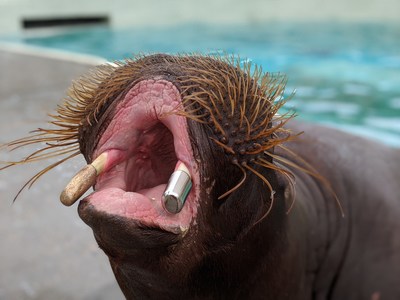3D printing to benefit the dental health of walruses
A collaboration between the École de technologie supérieure (ÉTS), the Aquarium du Québec and Université de Montréal's Faculty of Veterinary Medicine
MONTRÉAL, Oct. 28, 2020 /CNW Telbec/ - Three-dimensional printing is opening up new possibilities, and animals are benefiting from this, as demonstrated by a procedure performed on a walrus from the Aquarium du Québec. Thanks to this technology, a four-year-old female walrus weighing over 400 kg was able to receive a protective crown in less than five minutes, and without the need for anesthesia. The procedure was made possible by the expertise of Vladimir Brailovski, a research professor in mechanical engineering at the École de technologie supérieure (ÉTS); Dr. Claire Grosset, a professor of zoological medicine at Université de Montréal and a veterinary at the Aquarium du Québec; and Dr. Yvan Dumais, a clinician and teacher in veterinary dentistry at Université de Montréal.
Walruses are among the species of conservation concern in Canada. This is why four of them are housed at the Aquarium de Québec. The zoological institution ensures their reproduction and builds public awareness of their precarious situation in the wild. In the institutional setting, it is crucial that damage to their tusks be prevented, as such injuries could lead to dental abscesses.
Indeed, as indicated by its Latin name, Odobenus rosmarus, the walrus is an animal that "walks on its teeth," meaning it uses its tusks to hoist itself out of the water. "While this practice poses no problem in a natural environment made of ice and soil, things are different in a habitat comprised of concrete, metal and other materials selected to withstand these animals, whose weight can reach more than a tonne," explains Dr. Grosset.
To prevent fracturing and cracking of these mammals' tusks, veterinary medical experts recommend protecting the tusks with made-to-measure metal crowns, or caps. The technique helps avoid the need to remove the tusks, which is a more invasive procedure for the animal.
Since the metal with which crowns are manufactured varies from one institution to another, the team had to determine the metal best suited to 3D printing, a technique never before used to design crowns for these animals. The metal had to offer maximum resistance to repetitive rubbing and compression, and would not oxidize in salt water.
"We finally opted for cobalt chrome, a biocompatible alloy that is both hard and resistant to abrasion," explains Professor Brailovski. To ensure a perfect fit between crown and tusk, Professor Brailovski and his students Anatolie Timercan and Morgan Letenneur created three crowns, each of which offered a clearance of 0.25 to 0.45 mm between the tusk and the crown. The veterinarian was thus able to choose the one that best suited the walrus: too wide a gap between the tusk and crown would weaken the bonding of the glue, while too narrow a gap would keep the crown from fitting snugly against the tusk's surface. This careful approach sought to offset any errors that could have accumulated in the different stages of the process, from the physical taking of the tuskprint to its digitization and modeling using a 3D laser scanner and to the installation of the crown.
Aside from manufacturing the crown, a solution had to be found for installing the crown onto the walrus tusk without the use of anesthesia, as the mortality rate under anesthesia is particularly high for this species. Thus, over a period of several months, the walrus underwent training three or four times a day to increase its ability to remain immobile. The trainer rewarded these periods of immobility?which became increasingly longer?with a treat the walrus liked. The strategy paid off: the walrus ultimately stayed still for five minutes. The trust the trainer developed with the walrus made all the difference.
About ÉTS
École de technologie supérieure is one of ten constituents of the Université du Québec network. It trains engineers and researchers who are recognized for their practical and innovative approach, the development of new technologies and their skill at transferring their knowledge to companies. Almost one-quarter of all engineers in Québec graduated from ÉTS, which boasts 11,000 students, including 2,650 at the graduate and post-graduate level. ÉTS specializes in applied training and research in engineering, and maintains a unique partnership with the business sector and with industry. For more information, please visit etsmtl.ca.
About the Aquarium du Québec
The Aquarium du Québec is an institution dedicated to showcasing and conserving animal species and their environment, spreading knowledge related to them, and understanding the connections that unite us. It offers visitors an enriching, entertaining experience. The Aquarium is a member of Canada's Accredited Zoos and Aquariums (CAZA).
About Université de Montréal's Centre hospitalier universitaire vétérinaire
The Faculty of Veterinary Medicine's Centre hospitalier universitaire vétérinaire (CHUV), located in Saint-Hyacinthe, is a unique medical centre with as many as 24,000 visits each year. Offering continuous service, 24 hours a day, 365 days a year, the CHUV is comprised of specialized veterinarians considered experts in their respective fields. These professionals, along with the support of highly qualified technical staff, have access to state-of-the-art equipment, enabling the CHUV to offer a wide range of unique specialized services to veterinarians and pet owners. https://chuv.umontreal.ca/english
SOURCE École de technologie supérieure
News published on and distributed by:





